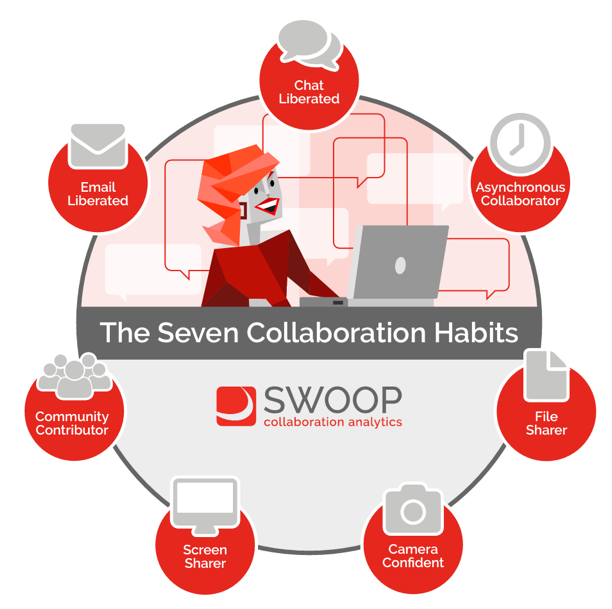How to successfully adopt good digital collaboration habits for hybrid working
As we move toward a more hybrid style of working, having good digital collaboration habits has never been more critical to success. SWOOP has designed Seven Collaboration Habits we believe embody the essence of good digital collaboration habits. They have been carefully designed for quantitative measurement and assessment by drawing data from the M365 Administration Usage Reports in close to real-time.
SWOOP Analytics’ recently released M365 Benchmarking Report anonymously assessed more than 113,000 staff from 18 different organisations for their digital collaboration performance. We identified from 3,773 groups those that achieved extreme levels of collaboration habit performance; meaning all members were unified around measurable good collaboration habits. We then approached a selection of these groups to hear their story. Without exception these stories were inspiring. Each story was rich with anecdotes of how new ways of working digitally had been discovered. All believed they were working more effectively now than they had pre-pandemic, and in the office. None wanted to return to previous ways of working.
What do good collaboration habits look like in practice?
We were fortunate to be able to publish a number of these inspiring stories in our benchmarking report. These stories show just what is possible. However, our benchmarking identified a wide range of performance, especially across the larger organisations in our benchmarking. This fact was reinforced by the organisations we reached out to. But at least now they felt that having even a single example of acknowledged best practice, along with a method for quantification, the process of building widespread excellence in digital collaboration could be put in train.
Of the organisations we reached out to, the following themes reoccurred:
“Guests” (external users) are not feared, but welcomed. Our best practice examples demonstrated how to achieve extreme levels of engagement between clients and partners by inviting them into their work teams. Regularly, guests were treated in the same way as internal team members. We saw this in managed service delivery (Real Foundations), Software Teams (CityFibre and SWOOP Analytics), and project delivery (Engaged Squared, Real Foundations, CityFibre and Christian Aid). That said, practices had been developed for managing the internal/external boundaries e.g. only inviting “active” guests, retaining mirrored teams with guests excluded where, for example, sharing internal process learnings.
The principles of “Working Out Loud” (WOL); a method for working transparently, was evident or explicitly mentioned. Regularly associated with Yammer usage, City Fibre, who are yet to use Yammer, have adopted WOL principles within their rapidly growing agile software teams, with great success.
Higher productivity was a consistent motivation for our leader groups. Working asynchronously through the extensive use of Teams channels and Yammer, in place of email, meetings and chat was a common, but expected, observation (after all, their SWOOP Collaboration Habits score measured this). We even heard of the “copying chat or emails into channels” practice, to help encourage good habits.
Training and education occurred well beyond simple technical training in the tools, to how to be more productive with an appropriate combinations of tools. Syngenta has instigated targeted group training on best digital habits, which has been highly sought after and appreciated. They have also instituted a “Work Better Wednesdays”, where the expert group runs interactive sessions for all comers.
Why habits?
As we engaged with our leader groups, the concept of change being centred on personal habits was strengthened. Leaders can achieve a lot through building their own collaboration habits and then publicly modelling these behaviours. Dictating behaviours from above, however, will rarely work.
In our benchmarking report we reference the methodology of best selling author James Clear’s habit changing framework:
We could see evidence of some of Clear’s methods informally being employed by our leader groups. The framework is being provided to help organisations systematise the process at scale. This is something we identified as critically required, with up to 50% of staff in many of the organisations we assessed, being “digitally disconnected”.
Habit measuring and monitoring
The large proportion of digitally disconnected, together with those looking to improve the way they collaborate digitally, is leading to a majority of groups having a large mix of digital collaboration competency. We found our leader groups have members who were unified around best personal collaboration habits. We also found the journey from groups having all members being digitally disconnected, to high performing, will require significant training and education interventions. In particular, support for peer-to-peer learning within existing groups will be key.
As groups and individuals learn to change their habits for the better, they will traverse the Cue, Craving, Response, Reward cycle articulated by James Clear. For this, measurement and monitoring in close to real time, becomes essential. This is precisely what SWOOP for M365 is designed for. The SWOOP for M365 dashboard monitors collaboration habits at the individual, group and enterprise levels:
Each of the Seven Collaboration Habits, along with an overall collaboration score, are updated in close to real-time. Habit scores are presented as performance percentiles, calculated against our benchmark database, as an external benchmark. Internal benchmark views are also available.
For the privacy protected personal dashboard, individuals receive hints and tips for improvements. Achievements are also recognised as the “reward” for improvements achieved.
For the analysts, time periods from six months to the most recent week can be assessed. Business segments i.e. departments, locations or any other attribute contained within the active directory, can be reported on.
Our benchmarking has uncovered “what good looks like” for M365 use; and it is inspiring. It doesn’t come without effort though. We hope SWOOP for M365 can play an important role in facilitating the adoption of best practice collaboration habits, at scale. This is something that will be essential if we are to navigate and thrive in the complex hybrid working world.




